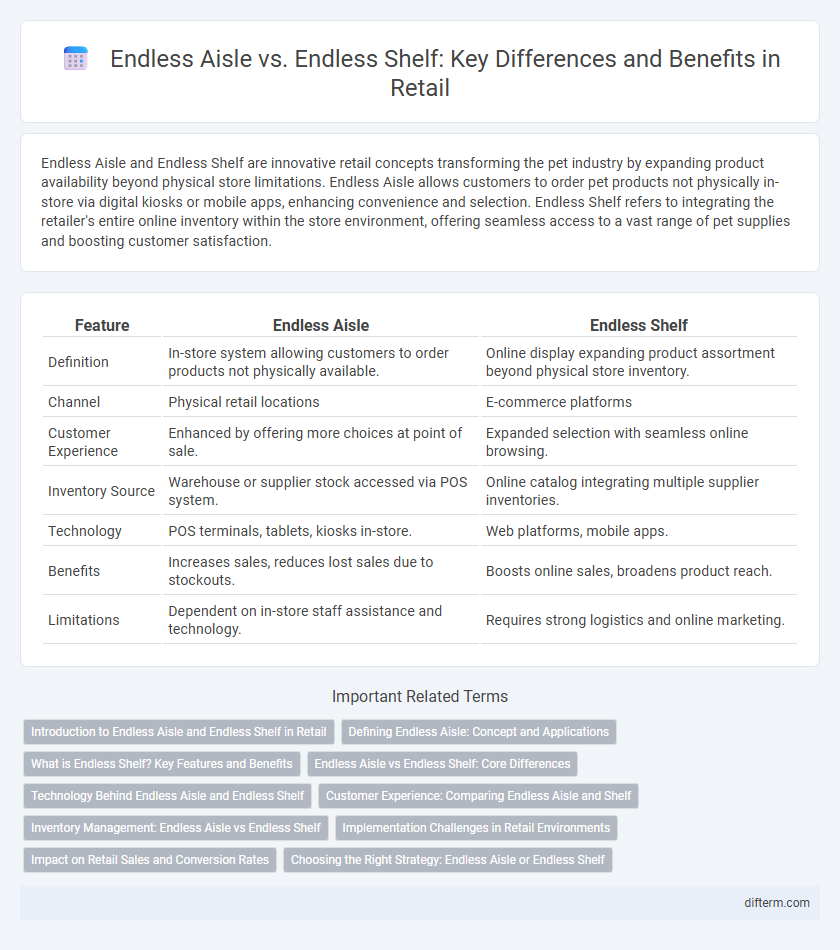Endless Aisle and Endless Shelf are innovative retail concepts transforming the pet industry by expanding product availability beyond physical store limitations. Endless Aisle allows customers to order pet products not physically in-store via digital kiosks or mobile apps, enhancing convenience and selection. Endless Shelf refers to integrating the retailer's entire online inventory within the store environment, offering seamless access to a vast range of pet supplies and boosting customer satisfaction.
Table of Comparison
| Feature | Endless Aisle | Endless Shelf |
|---|---|---|
| Definition | In-store system allowing customers to order products not physically available. | Online display expanding product assortment beyond physical store inventory. |
| Channel | Physical retail locations | E-commerce platforms |
| Customer Experience | Enhanced by offering more choices at point of sale. | Expanded selection with seamless online browsing. |
| Inventory Source | Warehouse or supplier stock accessed via POS system. | Online catalog integrating multiple supplier inventories. |
| Technology | POS terminals, tablets, kiosks in-store. | Web platforms, mobile apps. |
| Benefits | Increases sales, reduces lost sales due to stockouts. | Boosts online sales, broadens product reach. |
| Limitations | Dependent on in-store staff assistance and technology. | Requires strong logistics and online marketing. |
Introduction to Endless Aisle and Endless Shelf in Retail
Endless Aisle in retail enables customers to browse and purchase products digitally beyond the physical store's inventory, expanding product availability without additional shelf space. Endless Shelf, on the other hand, refers to the virtual extension of a retailer's assortment online, offering infinite product variety accessible through e-commerce platforms. Both concepts enhance customer experience by integrating physical and digital shopping environments, driving sales through omnichannel retail strategies.
Defining Endless Aisle: Concept and Applications
Endless Aisle is a retail strategy that integrates physical stores with digital inventory, allowing customers to access a broader product selection beyond the in-store stock through kiosks or mobile devices. This concept enhances customer experience by enabling seamless browsing, ordering, and fulfillment of out-of-stock or online-exclusive items directly from the store. Retailers implement Endless Aisle to increase sales opportunities, reduce inventory costs, and bridge the gap between online and offline shopping environments.
What is Endless Shelf? Key Features and Benefits
Endless Shelf is a retail strategy that extends a store's inventory virtually by connecting physical shelves to an online catalog, allowing customers to access a wider range of products without the need for additional physical space. Key features include real-time inventory syncing, seamless integration with e-commerce platforms, and personalized product recommendations. Benefits encompass increased sales opportunities, improved customer satisfaction through expanded choices, and optimized inventory management by reducing stockouts and overstock situations.
Endless Aisle vs Endless Shelf: Core Differences
Endless Aisle refers to an in-store digital solution that allows customers to browse and purchase products not physically available on the shop floor, expanding inventory virtually through kiosks or mobile devices. Endless Shelf, on the other hand, is an e-commerce or online retail strategy that extends product availability across multiple digital channels and platforms, ensuring seamless inventory integration and access. The core difference lies in Endless Aisle enhancing the physical store experience through technology, while Endless Shelf focuses on expanding product reach within the digital marketplace.
Technology Behind Endless Aisle and Endless Shelf
Endless Aisle technology integrates in-store kiosks and mobile devices with real-time inventory databases to provide customers access to products beyond physical shelves, leveraging RFID, barcode scanning, and cloud computing. Endless Shelf relies primarily on sophisticated digital shelving systems and augmented reality to display vast online catalogs seamlessly within the store environment, utilizing AI algorithms for personalized product recommendations. Both solutions depend on seamless backend integrations with ERP and supply chain management systems to ensure accurate, up-to-date product availability and dynamic pricing.
Customer Experience: Comparing Endless Aisle and Shelf
Endless Aisle enhances customer experience by offering in-store access to a retailer's entire online inventory, eliminating out-of-stock frustrations and enabling immediate purchase decisions. Endless Shelf extends product availability virtually, allowing customers to browse a broader selection at home, increasing convenience but potentially delaying gratification. Integrating both solutions balances instant physical availability with expansive digital choice, optimizing satisfaction through seamless omnichannel engagement.
Inventory Management: Endless Aisle vs Endless Shelf
Endless Aisle leverages real-time inventory management by integrating in-store and warehouse stock, enabling retailers to fulfill orders beyond physical shelf limitations without overstocking. Endless Shelf focuses on digital catalog expansion, relying heavily on accurate backend inventory synchronization to prevent stockouts and backorders across multiple online sales channels. Efficient inventory visibility and dynamic replenishment algorithms are critical in both models to optimize stock levels and enhance customer satisfaction.
Implementation Challenges in Retail Environments
Endless Aisle implementation challenges include integrating inventory data across physical stores and online platforms to provide real-time product availability, often requiring advanced POS systems and staff training. In contrast, Endless Shelf faces challenges in digital content management, accurate product categorization, and seamless e-commerce platform integration to enhance online customer experience. Both approaches demand robust technology infrastructure and continuous data synchronization to address stock discrepancies and maintain consistent pricing.
Impact on Retail Sales and Conversion Rates
Endless Aisle technology significantly boosts retail sales by enabling customers to access a wider product selection beyond in-store inventory, leading to higher conversion rates and reduced lost sales. Endless Shelf leverages digital displays to showcase extended product assortments visually, enhancing customer engagement and encouraging impulse purchases. Retailers implementing Endless Aisle or Endless Shelf solutions report increased average transaction values and improved customer satisfaction, directly impacting overall revenue growth.
Choosing the Right Strategy: Endless Aisle or Endless Shelf
Choosing between Endless Aisle and Endless Shelf strategies depends on inventory management and customer experience goals. Endless Aisle enables retailers to offer a wider product assortment in-store by leveraging digital kiosks or tablets, enhancing immediate purchase options without physical stock. Endless Shelf focuses on expanding available products through e-commerce integration, maximizing online visibility and fulfillment flexibility for seamless omnichannel retailing.
Endless Aisle vs Endless Shelf Infographic

 difterm.com
difterm.com